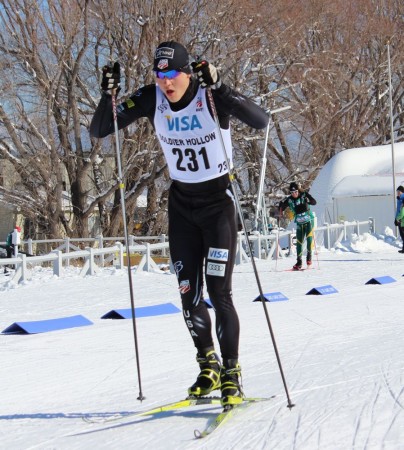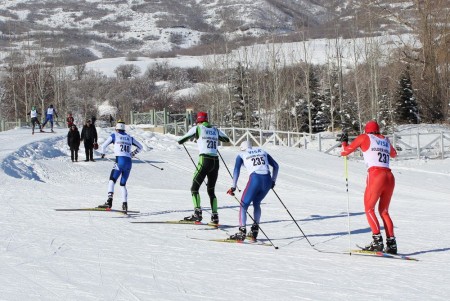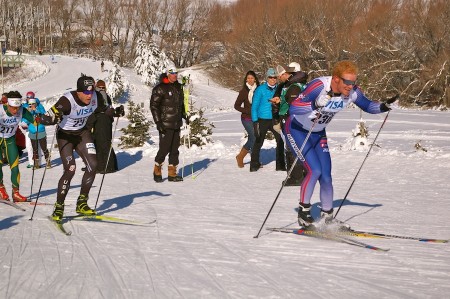
FasterSkier’s coverage of the 2013 U.S. Cross Country Championships is brought to you through the generous support of The Memory Clinic in Bennington, Vt.
MIDWAY, Utah — When Erik Bjornsen (Alaska Pacific University/U.S. Ski Team) lined up for the 15 k skate on Friday at Soldier Hollow, he wanted redemption. Two days prior he’d missed his first chance at a podium at U.S. Nationals in his strongest discipline, the classic sprint, with misjudged positioning in the quarterfinals.
The 15 k gave him another shot to ski where he belonged and he took it, winning the individual start event in 37:02, six seconds ahead of defending champion Tad Elliott (SSCV Team HomeGrown/USST). Matt Gelso (Sun Valley Ski Education Foundation) took third.

“I’ve never been top 10 in a distance race at nationals,” Bjornsen said, unable to stop grinning. “I woke up this morning and felt great. I really wanted some revenge after that sprint, so I’m just so excited.”
Only a year ago it would have seemed inconceivable that Bjornsen’s first national title would come in a distance event. Long pegged as a sprinter-only, then a classic specialist, the 21-year-old has now made himself into one of the top all-around skiers in the U.S.
“When he first came to us he was a sprinter,” said APU coach Erik Flora. “We talked about wanting to be both a sprinter and distance skier, so this has been a really big commitment to what he’s done.”
Bjornsen’s skating has made steady progress over the past few months to reach the point where it could win him national-caliber races. He began technique adjustments over the summer, playing with V2 rhythm on hills where he lives in Anchorage, and on Friday in Soldier Hollow it all paid off. The course used on Friday featured more gradual climbs and flat sections than the original Olympic 5 k, and the race favored those who could keep up their V2 speed with very little rest.
“The skating has been every week a little better, a little better,” Flora said. “And he just looked awesome out there today. I’m really happy.”
Bjornsen took to the course as the 31st starter, in the middle of the A-seed. Within 3 k he caught up to Gelso, who left the line 15 seconds in front of him. From there the duo remained locked in a one-on-one race, Bjornsen and Gelso each helping each other push the pace.

“It helped to have Gelso there; we were skiing together,” Bjornsen said. “The second lap I thought he was going to drop me.”
The race that unfolded on dozens of split timers around the venue was not with Bjornsen and Gelso, however, but between Bjornsen and Elliott. The two-time defending distance freestyle champion started nine places behind Bjornsen and produced split times that consistently remained in the lead by a few seconds for nearly the entire race.
That information spurred both men on but in the end only one could stand at the top of the podium.
“I was up four seconds on the climb, I kept hearing I was in the lead until the final stretch,” Elliott said.
Coaches yelled to Bjornsen on his final climb up Hermod’s Hill that he was still a few seconds down to Elliott.
“On that last hill it was, ‘You’re three seconds back on Tad, you gotta go for it!’” Bjornsen said. “I just did not have much left going up Hermod’s, but I gave it everything I had and my legs were just killing me and — it was just awesome.”

The focal point of many a race at Soldier Hollow over the years, the might of Hermod’s was somewhat lessened on Friday with an earlier turnaround point. Nonetheless, it was a defining moment for many. Those who did well could V2 through the beginning, while athletes who faded to a V1 lost time.
“This is a challenging course,” Flora said, who stood on the climb giving splits. “The hills aren’t so challenging but you just have to work all the time, there’s not much recovery. So the guys who were really strong were V2ing up the first part… On the second loop when Erik came around I thought, ‘OK, if he can just hold in there this is going to be good.’”
For Bjornsen, the key was skiing the transitions well and holding the V2 for as long up the climbs as possible. “Just skiing the whole thing consistently was important,” he said.
Then on the third lap, “[Bjornsen] looked great. I’m really happy for him,” Flora said, smiling and shaking his head.

“Espeically after that classic race…he could have done really well there, so this makes up for it.”
Elliott, who wanted to win his third straight distance freestyle race at nationals, appeared disappointed after results came through, but was happy for Bjornsen.
“It’s fun racing like that,” Elliott said. “You always want to end up on the plus side, but it was fun for sure. I really wanted to win in my adopted hometown but with second I’m pretty stoked. [Bjornsen] is a teammate, he’s a good guy. It’s awesome.”
Gelso, in third place (+15.6), thought his 12 k-long ski with Bjornsen definitely helped his own race. From the moment the eventual winner caught up to him from 15 seconds back, Gelso ramped up his effort to stay with Bjornsen and catch an advantageous ride where he could. In the end Gelso crossed the finish line a fraction of a second after him.
“I skied into the race,” Gelso said. “I thought I would have gone out too hard but I didn’t. Maybe I could have gone out harder, even [but] … It worked out pretty well.”
This is Gelso’s first medal at nationals. “I’m pretty psyched on my first nationals podium,” he said. “I’m psyched on that and excited for the 30 k.”
The men’s 15 k was a day for many personal-bests, even for the more veteran skiers in the field. Brian Gregg (CXC) finished fourth, 48.3 seconds off the winning time, for the best nationals result of his career. Elliott caught him from 45 seconds back at about 6 k.
“I was pretty surprised,” was Gregg’s initial reaction to getting caught from so far back. “I thought, ‘Aw man, I thought I started faster than that.’ But, you know, [Elliott] is a good guy to ski behind, and I thought, ‘Well, it’s never good to get caught but if you do, try to hang on.’”
After getting passed Elliott managed to hang onto Elliott, and crossed the finish line only a few seconds behind him.
Fifth place was yet another PB nationals performance, in this case for Patrick Johnson (SVSEF), who finished 1:01.2 off of Bjornsen.
“I was happy with it,” Johnson said. “I just went out there and tried to ski relaxed for the first part and push it towards the end. Some people complained about it not being the Olympic 5 k; I think it was still a hard course.”
Torin Koos (BSF/Rossignol), on the heels of winning the classic sprint on Wednesday, followed up with a 6th-place showing in his first distance race of the season.
“That’s solid,” he said. “But I’ll be looking for more on Sunday for sure.”
Seventh place was a two-way tie between Craftsbury Green Racing Project athletes Bryan Cook and Dylan McGuffin.
“It’s fun to have Green Teamers up there and it’s fitting that we tied since we train together all year,” Cook said.
The top college skier in the 15 k skate was David Norris (MSU) in ninth place. Sawyer Kesselheim (BSF), took the top junior honors in sixteenth.
Racing resumes at Soldier Hollow on Sunday with a 20/30 k classic.
— Alex Matthews contributed reporting.


Audrey Mangan
Audrey Mangan (@audreymangan) is an Associate Editor at FasterSkier and lives in Colorado. She learned to love skiing at home in Western New York.



